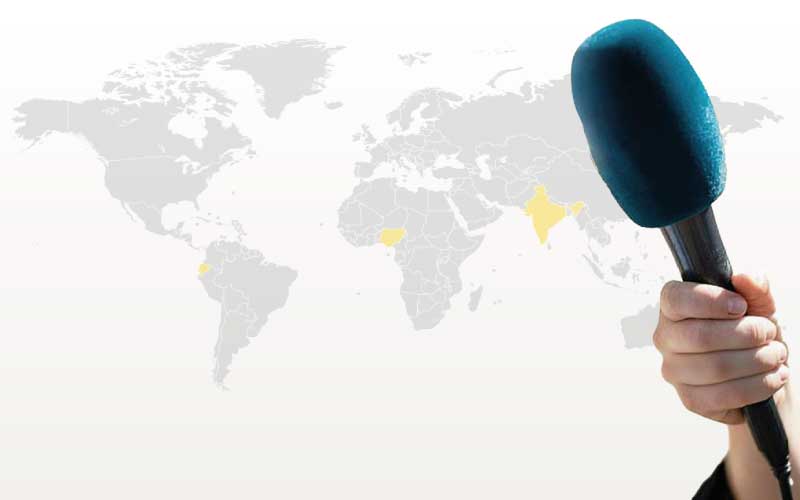As journalists, we passionately desire to break the big stories and catch the pulse of every environment we are put in. But what happens when the experiences transcend the familiar geography and we get an opportunity to observe new societies situated far away from home? That is a dream come true for most in the field of journalism.
I have had the incredible opportunity to live and work as a journalist in three diverse and dynamic places in the world—Guayaquil (Ecuador), Lagos (Nigeria), and various cities across my home country India. Each place has challenged, inspired, and shaped me into the journalist I am today. The lessons go far beyond newsroom experiences and has changed the way I think and write. But my journey did not follow the typical trajectory. I arrived in Guayaquil not on assignment, but as an expat wife and I am only beginning to create my journalistic life here.
Before Guayaquil, my husband and I lived in the cities of Akure and Lagos in Nigeria and various cities in India.
The journalistic experience in Guayaquil, India, and Nigeria reveals that, beyond geographical and cultural differences, journalism requires closeness to the community, ethical reporting, and creativity in the face of obstacles
GUAYAQUIL, ECUADOR – SOUTH AMERICA
I moved to Guayaquil with my husband, whose job brought us here. While I followed him, I also arrived as a professional, a participant, and a woman eager to write my own story in a city far from the place I call home.
Guayaquil is beautiful. It is green, picturesque, and has similarities to many parts of my hometown, New Delhi. The city exudes a warm and welcoming vibe, but the language posed a challenge for us in connecting with people. Spanish is tough! I had taken classes and used various apps, so I could manage the basics, like “¿Cómo está?” and “Una botella de agua, por favor.” However, learning a language in theory is very different from using it in real life—especially when it’s spoken at the fast, coastal cadence of Guayaquil.
It takes time to blend in. In the beginning, I struggled to understand half of the instructions given at government offices. At the pharmacy, I fumbled with Google Translate to request medicine. I once went to buy eggs (huevos) and accidentally said jueves (Thursday). There was even a moment when I had a mini panic attack in a café because I couldn’t figure out whether to say I wanted to drink my coffee there or take it home (¿Para servir o para llevar?). I was sweating as I saw nearly ten people waiting in line behind me, until a kind gentleman who spoke English stepped forward to help.
Ecuadorians are kind and patient. If you can connect with them, they often let you into their way of life and the broader culture. A year later, I find it easier to understand local news and the unspoken codes of society, allowing me to connect with journalists and teach journalism and English in the city. I regularly engage with a large group of corporate professionals and students by offering English courses through my platform, English Made Easy.
Reporting in Delhi versus Guayaquil
Guayaquil is the largest city in Ecuador in terms of geography, but it feels more like a small town where everyone knows each other. Journalism here is remarkably intimate; the stories are personal, and journalists are deeply embedded in the communities they cover. This is similar to the journalistic environment in New Delhi. Back in India, where I began my reporting career in 2011 with the crime beat, I used to report on all kinds of crimes; from petty ones to gruesome ones. My counterparts in other newspapers and I worked in an environment of constant threat and risk to life. Eventually, the threats had increased so much that my family pushed me to switch to another beat if I wanted to continue working as a journalist. Talking to the victims, coerceing the police to give leads into the story, following up on the investigation, reflecting on the law and order of the city, talk of the broader cultural and societal structure, talking to the residents, and hopefully never leaving the pursuit of bringing justice to the victims is what drives a crime reporter to do their jobs.
A major difference in crime reporting between India and Ecuador is the nature of the crime and how they are dealt with. Organized crime is not as visible in India as it is in Ecuador. Ecuadorian journalists cover crimes under immense pressure and threats from organized gangs and drug cartels, leading to increased safety measures like remote work and protective gear most of the times. According to Reporters Sans Frontiers, the nature of organized crime in Ecuador makes it one of the most dangerous places to work for a journalist in South America. India’s dangers stem primarily from government intolerance, harassment, and criticism of the ruling party.
Other differences arise from the variations in political climate, press freedom, media infrastructure, cultural context, and economic conditions. According to Reporters Sans Frontiers, here’s a comparison highlighting key differences:
- Press freedom– Ecuador ranked better in terms of press freedom than India in 2024. Ecuador ranked 110 out of 180 countries, whereas India was at 159/180.
- Government influence- There were increasing concerns about state influence over mainstream medium and some media outlets were pro-government. In Ecuador, however, there was some political influence over media outlets, but they were found to be less centralised than in India. However, the local governments were said to exert more pressure in cities like Guayaquil
- Censorship- Cases of censorship and harassment were mostly around sensitive issues such as the state of Kashmir and religion. In Ecuador, however, censorship was overall lesser, but the threats on journalists were more while covering crime, especially from organized crime groups.
- Diversity of Media- The Indian media is diverse. There are 1,55,000 print publications in over 33 languages, 908 private television channels, 550 radio stations, and a growing number of internet and social media users. According to Meltwater.com, an online media monitoring company, the number of social media users in India crossed 491 million by March 2025. On the other hand, the media variety in Spanish is limited to Spanish and is centred around national narratives. Journalism in Ecuador is also dependent heavily on national media from Quito and a few larger Ecuadorian networks.
LAGOS, NIGERIA – AFRICA
Prior to Guayaquil, we were in Lagos, Nigeria’s sprawling economic and cultural capital—possibly the most unpredictable media environment I’ve ever encountered.
In Lagos, journalism thrives in chaos. The daily challenges such as power outages, digital blackouts, and government silence force the journalists to be endlessly creative. The culture of investigative reporting is vibrant and there is a relentless hunger for accountability.
The most striking feature about even the most popular Nigerian media outlets is that they don’t enjoy the basic logitisical priveleges that are present in India and Ecuador. There are small teams of journalists in different cities, working under life threats, with a lack of reporting tools and gadgets like a good camera and recorders, convenient transport, roads, internet, police support and most importantly a government that does not regard journalism very kindly. Additionally, the nature of crime is more gory than the other two countries.
What is truly inspirational is the collective courage of Nigerian journalists. They tackle difficult issues such as police brutality, land grabbing, and political corruption—subjects that can be reported on more freely in countries like India and Ecuador without facing significant backlash. In Nigeria, however, reporters often operate under constant threats to their lives for even the smallest incidents or stories. As one editor from The Punch, the most widely read newspaper in Lagos, stated, “We are not fearless, but we’ve learned to work in fear.”
When I worked in Akure and Lagos, I was not part of field reporting. I was politely discouraged for that to remain safe. I was indeed part of the press clubs and was privy to the daily struggles of my fellow journalists in normal city reporting. I wrote full page columns on social upliftment, education, inspirational stories and pieces to help younger generations feel hope and desire to make something more of their lives. I also taught journalism in a university and was a regular at language schools curating english courses for them.
Unlike Ecuador, Nigeria’s official language was pidgin english, so language did not pose as a barrier.
SIMILARITIES
Irrespective of the geography, all the three places have interesting similarities in their journalism environments.
To begin with, all the three places demand that reporting is local in nature, touches emotional sensitivities of people and is trustworthy. Ethical reporting is key to remaining authentic and connecting with the masses.
Secondly, hustle is a skill. Irrespective of barriers, be it with logistics or with tackling political pressures, being innovative, creative and courageous are skills required by all the journalists to thrive in these places.
Thirdly, mitigating fake news, keeping oneself safe in dangerous reporting environments and using social media to share real stories are also similar features in the three places.
Last but not the least, as someone coming from a deeply layered country like India, I recognize that all the three countries have their own complexities—race, class, attitude towards work and life, gender dynamics, historical trauma, and economic tension. All these aspects, make journalism similar yet unique to each place.
FINDING FAMILIARITY AS AN EXPAT
Rediscovering my professional voice as a journalist in new linguistic and social contexts has been an interesting journey for me. However, beyond a professional identity, the unexpected friendships with Ecuadorians have been far more emotionally comforting. The Ecuadorians are warm and polite. Even as an outsider, you never feel isolated because nearly every person here greets you – buenos días – with a smile. I have never walked past a stranger here without a head nod and pleasantries. The neighbors I have met, manicurists and hairdressers, pharmacists, strangers in a market, and even children in the park are almost always uniformly kind. They have filled in my sentences, corrected me gently, and smiled often.
Rediscovering her professional voice as a journalist in new linguistic and social contexts has been an interesting journey, and the warmth and kindness of the Ecuadorians
Ecuadorians are familiar with Indians. They have seen them and worked with them. They know about Mahatma Gandhi, the famous political figure from India also regarded as the father of the nation, whose statue proudly looks over the Guayas River in “El Malecón”. Nobody has ever been able to identify me as an Indian from my appearance but always from my accent. They stop me in the streets of Malecón and ask about “India,” “¿De dónde eres?” “¿India? ¡Qué exótico!” There were assumptions that as an Indian I must be good at yoga. As a journalist, I knew it came from excitement and curiosity, not ill intent. So, I learned to answer with openness, patience, sometimes humor, and sometimes, a bit of storytelling.
Some of our closest friends in Guayaquil are Ecuadorians who invite us to their home like family, not guests. We listen to the Spanish guitar together and eat empanadas with Indian tea. The small but vibrant community of Indians in Guayaquil constitutes of families that have lived here for more than 25 years and have second-generation kids who speak Spanish like locals and celebrate Indian festivals like locals in India. This beautiful blend of two cultures, food, festivities, celebration and friendship make Guayaquil a charming city to live in. Guayaquil may not be my hometown, but it is certainly now my home.
Aditi Raman Shridhar is an Indian journalist currently living in Guayaquil with her family. She also teaches English through her platform English Made Easy. The views expressed in this article are personal.
BIBLIOGRAPHY
- Reporters sans frontiers on press freedom and media environment
- Outlook India. Press Freedom in India: Unofficial State of Emergency, Says RSF (2025) Outlook India
- TheCable.ng. Highest number of attacks on press freedom in West Africa recorded in Nigeria (2023) TheCable
- Wikipedia. Censorship in Ecuador — background on communications law and media regulation Wikipedia
- World Association of News publishers 2024




